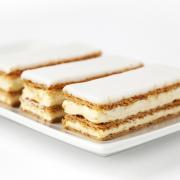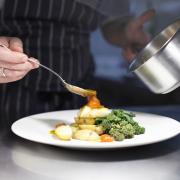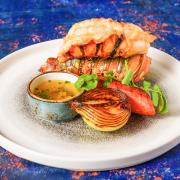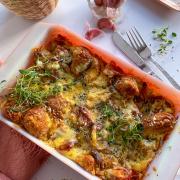Restaurateur and chef Gary Usher and his team reveal the secrets of their favourite dishes to help you create a stress-free, sensational festive feast at home.

For the past two years, Elite Bistro at Home, led by crowd-funding pioneer Gary Usher, has delivered Christmas to hundreds of diners across the UK through its fine dining recipe box service started at the height of the pandemic.
Christmas 2022 sees the group's bistros – Sticky Walnut in Hoole, Burnt Truffle in Heswall, Hispi in Didsbury, Wreckfish in Liverpool, Pinion in Prescot and Kala in Manchester – serving their communities, alongside the new Elite Bistros dining space and development kitchen in Chester and private catering.

Here, the Elite chefs offer up a menu based on some of their most popular dishes to try at home over the holidays. Group executive chef Richard Sharples says: 'We know it's tempting to go all out when you’re hosting. You want to impress your guests, so you end up researching recipes that’ll have you in the kitchen for six hours. But who needs that stress when the festive season is stressful enough? So take it easy and serve up some classic crowd-pleasers when you have people over this December.
'Our beetroot salad is a firm favourite of the Elite Bistro crew. It’s super-easy to prep at home but still has that ‘wow’ factor when plated up. And who can say no to a top-notch roasted chicken? This beautifully succulent spatchcocked chicken is served with a butterbean, saffron and parsley stew. For dessert, you can do no wrong with a custard tart. Try your best to get that perfect wobble... but even without it, you’ll be on to a winner having spent the day with minimal time faffing about in the kitchen.
Choosing a menu that gives you more time to enjoy chatting away with your guests is the way to go, in our humble opinion. Here's how...

Salad of roast and pickled beetroots, whipped ricotta, sticky walnuts and spiced pumpkin seeds
A dish served across all of our Elite Bistros and a top choice for many of our guests at Sticky Walnut where it has been on the menu for the past 10 years.
Serves: 4
Roast beetroots
Ingredients:
400g red beetroot
sea salt
fresh rosemary
vegetable oil
Beetroot
Method:
1. Set your oven to 180C/160C fan/gas 4.
2. Clean the beetroots by brushing them with a clean sponge to remove any dirt. If particularly
dirty rinse under running cold water to shift the dirt then set them onto cloth to dry.
3. Take a square, double layer of tin foil and place one individual beetroot at its centre, drizzle the
beet with a little vegetable oil then add a pinch of sea salt and a sprig of rosemary.
4. Wrap the foil around the beetroot forming a tight seal and place the wrapped beet onto
your roasting tray with the seal facing upwards. Repeat this process with each individual
beetroot. When you place them onto your tray ensure there is a little space between each one
so that the heat in the oven can circulate freely around them.
5. Bake until tender. Note: The cooking time varies drastically depending on the size and shape of the beets, check them for the first time after 20-25 minutes. You will know they’re perfectly done when a small paring knife travels through their centre with little to no resistance. If the skin on the beets looks as though it is beginning to wrinkle take them out.
6. Open the foil wraps and allow the beets to steam off at room temp for 5 minutes or so. Wearing gloves, hold a beet in your other hand and gently scrape the skin away with a small paring knife. Note: Do not leave the beets in their skin for too long before peeling them or the flesh will begin to take on an earthy, muddy flavour that isn’t pleasant.
7. Once fully peeled, leave the beets to cool whole, you can cut them into whatever size and shape you like later for the salad.
Pickled beetroot
Ingredients:
200g Cabernet Sauvignon vinegar
200g water
100g sugar
5g sea salt
1 peeled beetroot
Method:
1. Place the vinegar, water, sugar and salt into a saucepan. Bring everything to a boil then remove from the heat. Leave to fully cool before use.
2. Neatly peel the beetroot with a speed peeler.
3. Slice the beetroot into 0.5mm thick discs on a mandolin or gravity slicer.
4. Place the discs into a vacuum pouch and then pour enough of the now-cooled pickle liquor into the bag to cover the beets.
5. Seal the bag in a vacuum packer ensuring all the air is removed.
6. Refrigerate the pickled beets in their bag until needed.
Sticky walnuts
Ingredients:
160g caster sugar
160ml water
80g walnut halves
sea salt
Method:
1. Place the sugar and water into a saucepan and bring to a boil to dissolve the sugar.
2. Once the sugar is dissolved, shake the walnut halves in your hands to remove any loose skin then add them to the syrup.
3. Prepare a fork and a sheet of parchment paper on your work surface for when the walnuts are ready.
4. Boil the syrup until it reaches 121°C, watch your walnuts intently as keep the temperature will shoot up rapidly.
5. When ready, remove the pan from the heat and use a fork to scoop the walnuts individually from the pan. Place them onto the parchment paper separately of one another and allow them to cool.
6. Once fully cooled, deep fry the walnuts at 190°C until they stop fizzing. Remove them onto a fresh piece of parchment paper and season them with sea salt.
Ricotta
Ingredients:
200g ricotta
rind of 1/2 a lemon
1/4 of a nutmeg grated
pinch of salt
Method:
1. Add all of the ingredients to a bowl and beat until smooth. Place into a piping bag ready to
plate up.
Dressing
Ingredients:
80ml Cabernet Sauvignon vinegar
80ml Aberquina olive oil
Method:
1. Mix the oil and the vinegar together.
Spiced pumpkin seeds
Ingredients:
50g pumpkin seeds
1 tsp harissa paste
sea salt
Method:
1. Mix the ingredients together, spread onto a tray and bake at 160C/140C fan/gas3 for 12 minutes.
2. Allow to cool before use.
Bringing the salad together:
1. Make sure the beetroot is at room temperature before you begin. Add the chopped, roasted beetroot to a bowl and dress with the dressing. Season with sea salt and leave to sit for 5 minutes.
2. While the roasted beets are sitting in their dressing, take the pickled beets from their bag and drain them from the pickle liquor on a little cloth.
3. Take 4 cool plates (temperature not appearance) and split the beetroot chunks between them. Use a tablespoon to take them from the bowl allowing them to drain off a little and leaving the dressing in situ. Save the beetrooty dressing left in the bowl, you will use this to finish your dish.
4. Now take the ricotta and pipe it in between the beetroot chunks on each plate.
5. Top the roasted beets and ricotta with a few discs on the pickled beetroot.
6. Scatter each plate with 4 or 5 sticky walnuts and a small handful of spiced pumpkin seeds.
7. To finish, dress the place with the dressing left in the bowl and serve.

Spiced spatchcock chicken with saffron and parsley butterbeans
For best results marinate the chicken and make the saffron sauce the day before your dinner party.
Serves 4
Ingredients:
Saffron butter beans
180g double cream
375ml brown chicken stock
75ml cooking white wine
1 onion diced
pinch of saffron
1 garlic clove minced
good pinch of salt
90g arborio rice
1 large jar of good quality cooked butter beans
3 tablespoons parsley chopped
Chicken
1.5kg whole chicken
4 garlic cloves minced
2 teaspoons fine salt
1 teaspoon dried oregano
1⁄2 teaspoon thyme
5 tablespoons vegetable oil
2 tablespoons smoked paprika
1 tablespoon chilli powder
2 tablespoons lemon juice
Method:
Ahead of time:
1. Spatchcock the chicken by removing the strip of the backbone with a sharp, strong knife. Flatten the bird with its breasts and legs facing upwards.
2. Mix all the remaining ingredients to create a marinade and rub this all over the chicken, cover, and leave in the fridge for 12 hours.
3. Now make the saffron sauce. Bring all the ingredients except the rice to the boil. Once boiled, remove from the heat, add the rice, mix. Cover the mixture with baking paper then seal the pan with a triple layer of cling film, and then a triple layer of foil.
4. Bake this in a hot oven (180C/160C fan/gas 4) for 25 minutes or until the rice is completely tender and overcooked.
5. Once the rice is mushy and overcooked. Transfer the mix to a high-speed blender and blend on full speed for 5 minutes until glossy and smooth.
6. Check the seasoning then pour the mixture into a container and place a sheet of baking paper over the sauce before chilling.
On the day:
1. Preheat the oven to 180C/160C fan/gas 4.
2. Place the chicken flat on a roasting tray lined with baking paper and roast for 30 minutes. Then, turn up the oven to 200C/190C fan/gas5 and roast for a further 10 minutes, until the chicken is cooked through. Remove from the oven and allow to rest for at least 15 minutes before serving.
3. While the chicken is resting, gently heat through the saffron sauce and add the beans. Stir the pan often as the sauce has a tendency to catch. If it becomes too thick then just add a splash of hot water to loosen it back up.
4. Check and adjust the seasoning with a little lemon juice and salt and finish with the chopped parsley.
Serve alongside the chicken and a crisp, fresh green salad.

Custard tart
Serves 10
This tart is a staple of the menu at Hispi in Didsbury. We make one tart for each dinner service and once it's gone, it is gone. The addition of a little salt to the recipe really makes the custard come alive and it actually came about when the head chef accidentally spilt salt into our caster sugar bin and forgot to tell the pastry section. A happy accident. Don’t be too harsh on yourself if your custard is a little overset or your pastry a little soggy, it will always be delicious and you’ll have an excuse to make it again.
Ingredients:
Custard
250g egg yolk
800ml double cream
160g caster sugar
1/2 teaspoon salt
Pastry
1 egg
125g caster sugar
350g plain flour
250g unsalted butter, cubed and chilled
To seal the tart
1 beaten egg yolk
To finish the tart
1 whole nutmeg finely grated
Method:
The pastry and custard mixes for this recipe are best made the day before you want to make the tart, this gives the pastry time to fully rest and it gives the ingredients for the custard time to become good friends. If you’re a little short of time make the pastry at least 4 hours before rolling your tart, the custard mix can be made just before use.
1. Place the flour, cubed-cold butter and sugar into the bowl of a stand mixer fitted with the beater attachment. Mix on a low speed until the butter has fully incorporated into the flour and sugar and has a consistency of bread crumbs. Crack the egg and whisk until an even yellow colour, add this to the flour mixture in the stand mixer and work it on a low speed until a dough has just begun to form. The key word in these instructions is ‘just’.
2. Tip the dough out onto your work surface and using your hands bring it together to form a ball.
3. Wrap the dough tightly in clingfilm then push down on it slightly to form a round disc about 2cm thick. Place this in the fridge overnight or in the freezer for an hour if a little pressed for time.
4. To make the custard mix, gently combine all the ingredients together until the sugar is completely dissolved. Don’t beat it as you need as little air in the custard as possible. Once the sugar is fully dissolved, pass the mixture through a fine sieve and refrigerate the custard until later.
5. Now your pastry is fully chilled and well rested, take it from the fridge, unwrap it and place onto a lightly floured work surface. Holding one end of your rolling pin, bash down on the dough turning it 45° each time you do, until you have a rough circle of around 18cm diameter. The reason for doing this is to work the pastry as little as possible and limit the amount of heat transfer from your hands to the rolling pin to the pastry.
6. Now conventionally roll the pastry into a circle around 24cm in diameter and 3mm thick. Gently roll the pastry up and around your rolling pin then lay it over a 20cm tart/sandwich tin. Gently press the pastry into all corners of the tin and leave all the excess hanging over the top. Check your pastry for holes as this will be crucial to avoiding a soggy
bottom….and nobody likes a soggy bottom. If you can see any holes, patch them up with any excess dough.
7. Chill the pastry in its tin for at least one hour before starting to bake.
8. Set your oven to 180°C/160°C fan/gas4 to preheat.
9. Line the tart case with a piece of scrunched-up baking paper and fill it with baking beans or even better, uncooked dry rice. Blind bake the tart for 20-25 minutes until the outer rim has turned a deep golden colour.
10. Around 20 minutes into your bake, add the custard mix to a saucepan over very low heat. Continuously but gently stirring the custard bring it up gently so that is lukewarm to the touch.
11. After 20-25 minutes remove the paper and rice/beans from the tin and bake the pastry for a further 10 minutes until the base is a lovely, deep golden colour. Using a pastry brush, brush the tart case with 1 beaten egg yolk and bake for a further minute; this will shore up any holes in the tart that may have formed during baking.
12. Reduce the heat to 120C/100C fan/ gas ½ and open the door for a minute or so to help it along.
13. Carefully pour the custard mixture into the tart case, skim away any bubbles that rise to the top then bake until only a slight wobble remains at the custard’s centre. This can take any amount of time between 15 minutes and 1 hour, as there are many temperature variables to consider. We suggest checking it for the first time after 15 minutes and if the custard is still completely liquid give it another 10 minutes before checking again. If after 15 minutes you can see around the edge of the tart that the custard is beginning to set, check it every 5 minutes. Be brave, if the wobble at the centre of the tart is only slight and returns to its original position almost immediately when jiggled take the tart out, its residual heat will continue to cook the custard, leaving you with a perfect, silky smooth texture.
14. Allow the tart to cool slightly then grate a whole nutmeg over it. The tart is best at room temperature, you can refrigerate it and eat it the next day, it's still delicious but a completely different thing.
*Elite Bistro At Home's restaurant-quality, festive recipe boxes are delivered nationwide, direct to your door in time for the big day.
Order online and select turkey, beef or squash for two or four, with all the trimmings.
There is also a selection of add-ons including the Christmas Day Brunch Box, and Cheese Box with a selection of favourites from the British Isles.
elitebistroathome.com/pages/christmas


























